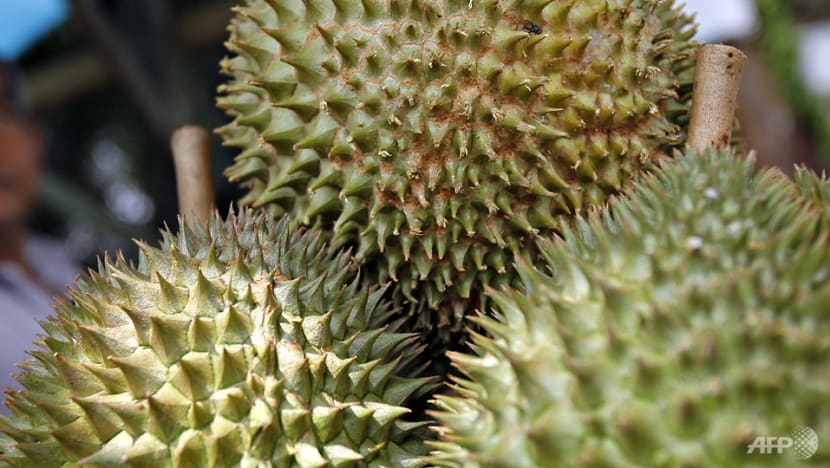Johor durian prices could spike in upcoming season as farmers expect 50% fall in yield due to floods
The peak annual durian season in Malaysia typically happens from May to August.

File photo of durians. (Photo: AFP/Tengku Bahar)
JOHOR BAHRU: The recent bout of heavy rain and floods which hit various parts of Johor has upset the durian harvest for the upcoming season later in May.
This will potentially reduce the supply of durians by half and in turn, result in price increases for some varieties that are exported to Singapore and China, farmers told CNA.
Mr Francis Hong, vice-president of the Malaysian Fruit Farmers Association, said the heavy rain and floods over the past month have occurred during a critical juncture of the harvesting process for durian farms in areas such as Segamat, Batu Pahat and Muar.
“The bad weather in early March has disrupted the flowering process for many of the durian trees in these areas and this will impact the harvest for the upcoming season significantly,” said Mr Hong, who is also chairman of the Johor Fruit Farmers Association.
“Because of the lack of sunlight and floodwaters damaging the trees, the flowers in many of these trees have failed to mature, and the fruits will not be formed. I think Johor will likely produce 50 per cent less durians as compared to previous years,” he added.
The peak annual durian season in Malaysia typically happens from May to August.
Prolonged heavy rain in early March had led to floods across various parts of northern and central Johor, including Batu Pahat, Kluang, Pulai, Muar as well as Segamat, an area popularly known for producing good quality durians.
At its peak, around 50,000 people were displaced from their homes during the floods. However, that figure has declined since.
According to the National Disaster Management Agency, about 6,160 people were based in temporary relief centres as of Tuesday (Mar 21) afternoon.
Durian consultant Lim Chin Kee told CNA that it is inevitable that the floods in Johor have adversely impacted durian supply.
Mr Lim, who owns a durian plantation in Raub, Pahang, said that the rain and floods cause the roots to be impacted by fungus in the soil, and this may cause seedlings to wither and die before they fruit.
“The continuous rainfall has also caused many durian trees to have rotten roots. Some durian orchards in Johor have very high casualties, others have minor casualties, but overall harvest is significantly impacted,” he said.
SUPPLY DISRUPTION COULD RAISE PRICES
Mr Hong said the supply disruption could raise the prices of Malaysian durians, including those that will be exported for the upcoming season to Singapore, China and other countries.
“I think with the significant drop in supply from Johor - combined with China now opening up their market to import durians again this year - the prices of durians could increase,” he added.
Mr Hong, who owns a farm in Kluang, Johor, said that the popular durian varieties such as Mao Shan Wang, Red Prawn and Black Thorn will “likely be slightly more expensive” when the season commences in May.
Mr Mad Zin Abdullah, who owns a durian plantation in Kampung Tengah in Segamat, told CNA that the prices of the Musang King, or Mao Shan Wang varieties from Segamat would likely cost 50 per cent more this year.
“Typically the price of Musang King durians exported to Singapore and China are between RM40 and RM45 (US$8.90 and US$10) per kg. I think because they are so scarce, especially in Segamat, the price could go up to RM60-65 per kg,” said the veteran farmer who is in his 70s and specialises in farming hybrid durians.
Mr Mad Zin’s farm was hit with floods in the first week of March, destroying his wooden home, some vehicles and around half of the durian trees. However, he stressed that he is thankful he still has undamaged trees available to continue his harvest this year.
“We don’t want to price durians excessively high, just at a reasonable amount in line with the market,” he added.
Read this story in Bahasa Melayu here.
















